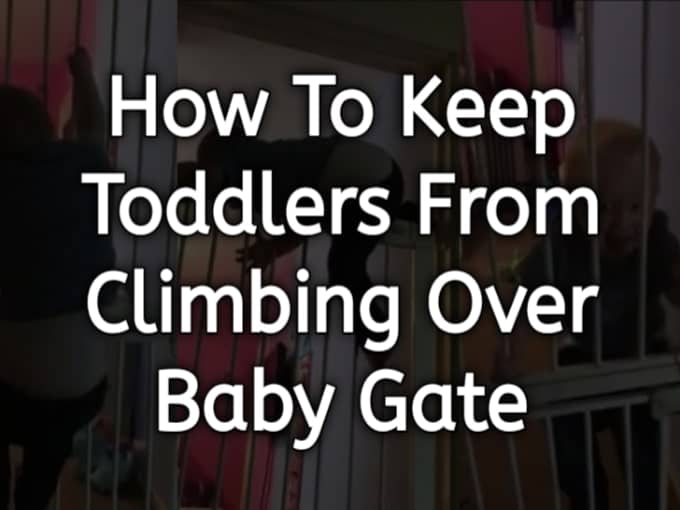Table of Contents
ToggleDealing with a toddler’s boundless energy and curious nature can sometimes feel like a full-time job. It’s especially true when it comes to keeping them safe and out of harm’s way.
One such challenge parents often struggle with is keeping their toddlers from climbing over the baby gate.
These baby gates are installed to create a safe, controlled environment for your little one, but what happens when your toddler sees them as the latest climbing frame?
Understanding how to keep toddlers from climbing over the baby gate is crucial to ensure their safety and your peace of mind.
This guide offers five unfailingly effective methods to prevent your toddler’s mini-escapades and maintain a safe home environment.
Understanding Why Toddlers Climb: Exploration and Attention Seeking:
Toddlers are natural explorers. Their urge to understand the world around them often compels them to push boundaries, literally in the case of baby gates.
Climbing is a form of physical exploration that helps them develop mobility, coordination, and problem-solving skills.
It’s an integral part of their cognitive development, and while it indicates their growth and curiosity, it can also lead to potentially dangerous situations.
On the other hand, toddlers may also climb baby gates to seek attention. If they notice that climbing over the gate earns them an immediate reaction – be it laughter, shock, or a dash to pick them up – they may associate the act with getting noticed.
This can motivate them to repeat the action, turning the baby gate climbing into an attention-seeking behavior.
Understanding these motivations behind your toddler’s climbing habits is the first step towards effectively stopping them.
5 Effective Methods: How to Keep Toddlers from Climbing Over the Baby Gate.

Method 1: Reinforcement of the Gate:
Choosing the correct type of gate and reinforcing it properly can significantly deter your toddler from climbing.
Suitable Gate Types:
Opt for a gate with vertical bars or a mesh design without footholds to discourage climbing.
Avoid gates with horizontal bars or decorative cut-outs that might tempt your toddler to use them as steps.
Pressure-mounted gates can be easily pushed out by a determined climber, so hardware-mounted gates, which are screwed into the wall or door frame, are a safer choice.
If you want to Know Which baby gate type is best for you click here…
Effective Reinforcement Techniques:
Reinforce the gate by securing it firmly to the door frame using strong brackets and screws.
If you’re using a pressure-mounted gate, you can enhance its stability with the addition of wall cups.
Regularly check the gate for any signs of wear and tear, and make sure it’s always properly latched.
For extra security, you can also add a second, taller gate above the existing one, creating a two-tiered barrier that’s harder to scale.
Also, remember to always keep the area around the gate free from any objects that your toddler could use to climb over it.
Method 2: Distraction Techniques, Appropriate Toys, and Games, Safe Environments for Play:
Toddlers are easily distracted and their attention can be swiftly steered toward something more secure and fun.
Consider placing their favorite toys or introducing exciting new games on the safe side of the gate.
This can make the area more appealing, reducing their desire to venture to the other side.
Appropriate Toys and Games:
Choose toys and games that engage your toddler’s interest and stimulate their curiosity.
Interactive toys, building blocks, puzzles, and age-appropriate board games can keep them happily occupied.
Avoid toys that could potentially be stacked and used as a step to climb over the gate.
Creating Safe Environments for Play:
Identify safe zones within your home where your toddler can freely explore and play. Equip these areas with soft rugs or mats to cushion any accidental tumbles.
This could include a corner of the living room, a childproofed bedroom, or an outdoor play area.
By ensuring these zones are fun and stimulating, your toddler will be less likely to see the other side of the gate as an enticing challenge.
Method 3: Communication and Instruction:

Believe it or not, often toddlers can understand much more than we give them credit for.
This comprehension can be used to guide their behavior, even when it comes to staying behind the baby gate.
Age-appropriate Explanations:
Take the time to explain to your toddler why they should not climb over the gate. Use simple, age-appropriate language that emphasizes safety, for example, “The gate is here to keep you safe from falling or getting hurt. Climbing over it can cause boo-boos, and we don’t want that, do we?”
Consistent Instructions:
Be consistent with your instructions and reminders about the gate. If your toddler attempts to climb, gently redirect them and reinforce the message that the gate is not for climbing.
Consistency is key in helping toddlers understand and follow the rules.
Always reinforce the same safety message, and over time, your toddler will understand that they should not attempt to scale the baby gate.
Method 4: Supervision and the Importance of Routine:

Establishing a routine and properly supervising your toddler can go a long way in ensuring their safety around baby gates.
Importance of Constant Supervision:
While baby gates are designed to offer some level of protection, they are not a substitute for active supervision.
Always keep an eye on your toddler, especially when they are near the gate.
Direct supervision can help prevent any attempts to climb and allows for immediate intervention if they do try.
If you are occupied with other tasks, consider involving them so they stay within sight.
Establishing Routines for Safety:
Routine provides a sense of security and predictability for toddlers. Establish consistent routines around areas gated off, such as specific playtimes in the safe zones, or a routine of closing the gate every time you step into another room.
This pattern creates an understanding that the gated area is off-limits, discouraging climbing attempts.
By incorporating the baby gate into your toddler’s daily routines, it becomes a familiar part of their environment, rather than an obstacle to overcome.
Method 5: Child-Proofing the House: Essential Measures, and Room-by-Room Guide.

Child-proofing your home is another effective strategy to ensure your toddler’s safety. It involves making necessary modifications in each room to remove potential hazards.
Essential Measures for Toddler-Proofing:
Begin with securing all heavy furniture such as bookshelves, dressers, and TVs to the wall.
This prevents these items from tipping over should your toddler try to climb them. Install corner guards on sharp furniture edges to prevent injuries.
Secure cords and blinds out of reach, and cover all electrical outlets. Also, secure cabinets and drawers with child safety locks, especially those containing cleaning supplies, medication, or other potentially harmful substances.
Room-by-Room Guide:
Kitchen:
Install safety latches on cabinets and drawers. Use stove knob covers and oven locks to prevent your toddler from turning on the stove or opening the oven. Keep all sharp objects, cleaning supplies, and medications safely out of reach.
Living Room:
Ensure all heavy furniture is anchored to the wall. Use corner and edge bumpers on furniture with sharp edges. Place breakable items out of reach. Secure window blinds and cords well out of your toddler’s grasp.
Bathroom:
Install toilet locks to prevent toddlers from opening the lid. Non-slip mats can prevent slips and falls. Adjust your water heater to a lower temperature to prevent scalding.
Keep all medications, razors, and cleaning supplies in a locked cabinet.
Bedroom:
Secure all heavy furniture to the wall. Keep toys within easy reach in low drawers or shelves. Install window guards and keep blind cords out of reach. Make sure all small items that pose a choking hazard are out of reach.
By thoroughly child-proofing your home, you can allow your toddler more freedom to explore while minimizing the risk of accidents.
This can lessen their desire to climb over the baby gate, as they’ll be more occupied with their environment.
Are there any tricks for preventing a toddler from climbing a baby gate?
While it’s essential to keep in mind that every child is different and not all methods work universally, there are a few tricks that could deter a toddler from climbing a baby gate:
- Distraction: Keep your child occupied with toys, books, or activities that they enjoy. A bored toddler is more likely to look for adventure, like attempting to climb a baby gate.
- Reward System: Implement a reward system for following safety rules. This could be in the form of an extra story at bedtime, a sticker, or a small treat. Praise your child for staying behind the gate, reinforcing positive behavior.
- Model Behavior: Show your child how to use the gate properly (opening and closing it). Toddlers are keen observers and often mimic adult behavior.
- Right Equipment: Ensure that the baby gate you are using is sturdy, securely fitted, and appropriate for your child’s height and weight.
Remember, these tricks are not foolproof, and supervision remains the most effective method to ensure a toddler’s safety.
Conclusion:
In conclusion, keeping your toddler safe and entertained while preventing them from climbing over baby gates requires a multi-faceted approach.
This involves the strategic placement of the gate, providing engaging toys and games, creating safe environments for play, establishing clear communication and consistent instructions, and incorporating the gate into your toddler’s routine.
Moreover, thoroughly child-proofing your home can foster a safe environment that allows your little one to explore freely.
Each of these methods plays a crucial role in ensuring your toddler’s safety and curiosity are both nurtured effectively.
However, remember that as parents, you are doing an amazing job, even when facing challenges.
It’s important to remain patient and consistent, knowing that each step taken is building a safe and engaging world for your child.
It is a learning process for both you and your toddler. Keep going!



